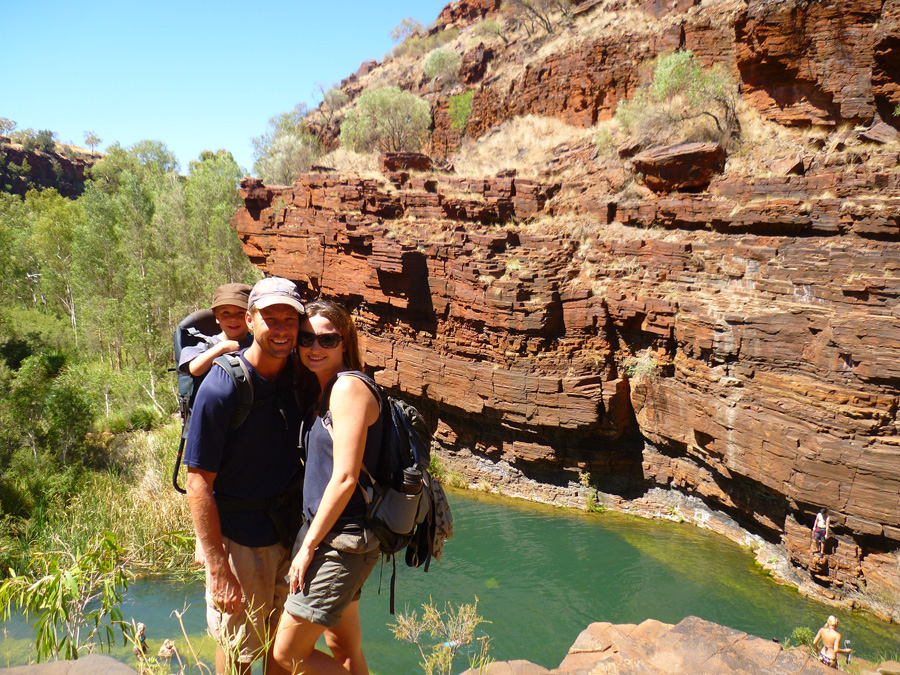Karijini National Park, Western Australia
March 30 – April 3

Ryan was beginning to think he was going blind. It was approaching four in the afternoon, and he had been behind the wheel since seven in the morning, with one stop at a fly-bitten outback roadhouse for over-priced gasoline and a couple of meat pies. The UV index was probably comparable to that in outer space and, in the backseat, Ollie had been babbling to himself incoherently for the past 150 miles. Ryan had been seeing black spots floating in his periphery, and they weren’t just the hundreds of roadside kangaroo carcasses that had met their demise in the headlights of a oncoming road train. With two or three trailers in tow, these mechanical monsters often reached 150 feet in length, and they regularly plied the two-lane, shoulderless highways after dusk. Of course they didn’t brake for anyone or anything, least of all the six-foot reds that tended to hop right onto their strip of bitumen. Avoiding them, and their accompanying shower of windshield-shattering gravel, was reason enough to stay off the roads once the sun went down. The locals were fond of reminding us that if the big trucks didn’t get us, the ‘roos most certainly would.
It’s the thought of one of these animals plowing through our windshield that causes me to continually glance up in the rearview mirror to check the angle of the sun. It’s going on 5:30pm now, and we are losing our light. The glimmer that had entered Ryan’s eye when we pulled into the filling station in Paraburdoo had long since vanished when the attendant informed us that we still had another 130 kilometers to Tom Price, the gateway town to our next destination: Karijini National Park.
This was a place neither Ryan nor I had ever heard of when we arrived in Australia. But when the creep travel agent in Perth matter-of-factly described Karijini as one of the least known but most spectacular of Australia’s destinations, and then brandished a photo from his recent trip there, our interest was piqued. His print depicted some kind of red planet full of gorges, subterranean green rivers and strange plant-life. And curiously, there didn’t appear to be any other people! In other words, it seemed to precisely figure as that wild image of Australiana that people from far faraway lands tend to maintain within their collective conscious. At least to us, Karijini was the proverbial “Outback”.
Entering that place as the last ribbons of sunlight snaked across the cinnamon-earth was as if an ancient Aboriginal Dreamtime tale had breathed life into the bush all around us. Ocher-hued spinefex grew in round, bristly tussocks and appeared as if they had emerged from the pages of Robert Louis Stevenson. Ghost gum trees rose from the ground like graceful bony fingers to grasp an amethyst sky. I dubbed them “Venus Trees”, as their white limbs called to mind Botticelli’s famous subject. Where her arm bends to sweep aside a tendril of sea foam hair, the delicate fold of skin yielding to skin is the same subtle, feminine ripple in the bark where a branch diverged from another. In the distance, Mount Bruce cut a figure in a shade of plum and vibrated above the heat-halo that lay across the land like an electric blanket. We slept that night in the bush beneath a full moon, and dingoes cried from out in the desert until the dawn came, lighting everything in a trail of fire all over again.
But the Karijini’s calling card was not necessarily its horizon. 400 feet below us, jagged gorges split the earth like shards in a pane of glass, and underground rivers welled from their depths to run through the canyons like primordial arterial blood. This sparsely populated and semi-arid region of far Northwestern Australia is steeped in Aboriginal creationist mythology, which describes a Dreamtime serpent that emerged from the sea and slithered across the land, forming great rivers and pools as he went.
Geologically, Karijini was once an ancient seabed that was formed by layers of fine-grained sediment that over the course of hundreds of millions of years, became a composite of iron ore and silicate. As Western Australia became an increasingly arid region, the gorges were created when a sharp drop in sea level caused the rivers to down-cut rapidly. The 2,500 million year-old geological formation had a spirit all of its own; the red and gray and blue-layered rock had seen a long and particularly violent history, and it was as if the lucid bluegreen pools that welled up inside were a salve for wounds that ran as deep and brutal as the fiery core.

Kalamina was our first gorge, and it was in its center that we stood, on top of an impossibly smooth plane of ferrous rock and gazed up along the ancient cliffs. Their bandy sides were rubbed as soft as soap by rivers that had flowed past for millions of years. With Ollie strapped tightly to Ryan’s shoulders, we scrambled down Knox gorge’s scree-covered slope which might as well have been covered in metallic shrapnel. Once at the bottom, we set Ollie down in a dew-drop of a canyon pool, where he paddled in its translucence as Ryan and I took turns leaping from the ledges above.
Eight long hours after gorge-trekking, we returned to our campsite only to discover that a particularly strong desert wind had, at some point earlier in the day, sheared two of our tent poles neatly in half. Our campsite lay in tatters and appeared as if a rogue elephant had run through it, with our camp chairs, table and little gas cooker strewn every which way into the surrounding spinefex. That night the three of us bedded down in the back of our minivan, where a free-for-all competition for the most elbow room kept each of us grumbling into the very early hours.
The following morning, we woke with sour dispositions and a flat car battery. All were cured after several mugs of instant coffee, and before long, we were back on the plain and into Dales Gorge, a tremendous hike that led us from the spectacular Fern Pool, past the Fortescue Falls, and finally to the Circular Pool, where Banyjima, Yinhawangka and Kurrama Aborigines once frequented, seeking everlasting life. Here we discovered tiny waterfalls that, heated on land by the sun, ran in warm rivulets down the canyon walls.

In Weano Gorge, we traipsed after a rough-and-tumble family from Karratha as they led us down a narrow track to Handrail Pool. This waterhole’s namesake was owed to the treacherous manner in which a visitor makes their approach to the pool, via a bolted-in handrail one is instructed to grasp as they step backward off a ledge that drops thirty feet into the pool below. At the end of the rail, one belays themselves down the remaining 12 feet with the aid of old, knotted rope that was tied to the end the handrail. Understandably, at this juncture, the track transitions from a level 4 grade (“only attempt if you’ve packed a well-stocked first aid kit“) to level 5 (“you will most certainly die attempting this, the DOC entreats you to reconsider your route“). As luck would have it, one of the Karrathans was carrying his own 27 month-old son down to the pool, and he made the descent look like a walk in the park. “You put one foot ‘ere, and then the otha’ ’ere, hands down the rope, and she’ll be right! No worries, mate! Give er‘ a go!” This was Western Australia after all, and the people were cut from the same hard earth that they stood on. But we reckoned, if they could do it, so could we.
We left Karijini breathless and besmirched in red dust. It had found its way everywhere and onto and into everything; from the console of our car, to the creases of our oily, rusty grins, into the corners of our eyes and the backs of our knees. From here the Pilbara was wide open and without a spot of civilization for more than 80 miles. We sped off with the specter of Mount Bruce and the Hammersley Range in our rearview, the light falling delicate and mauve across the dusty quilt an eternity of time had stitched into this remote corner of the earth.


